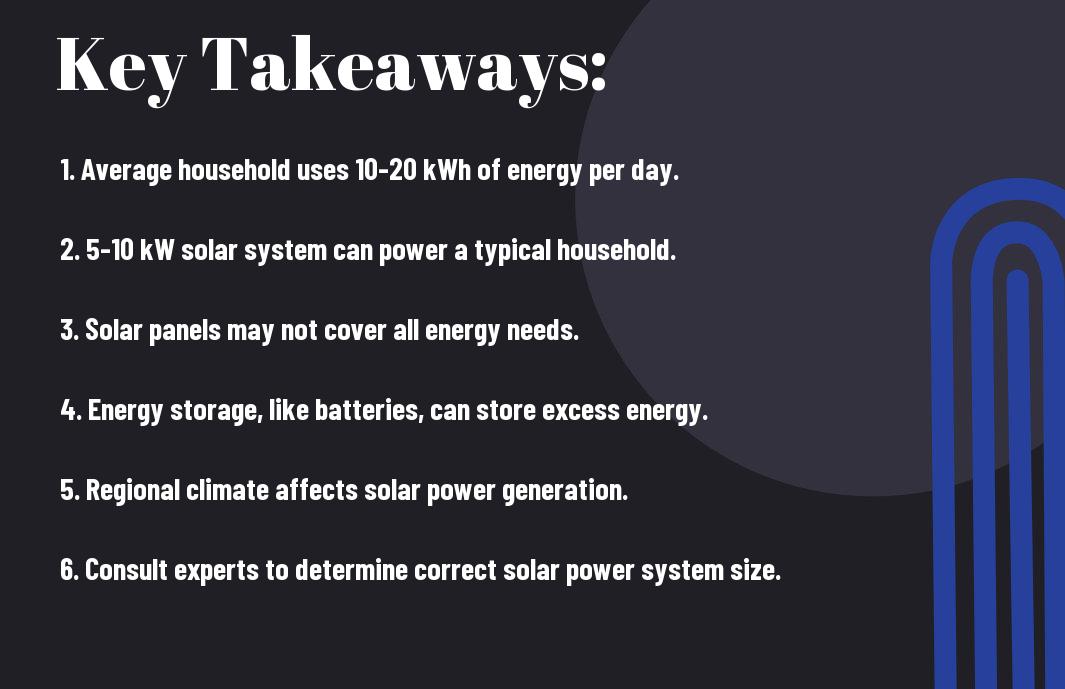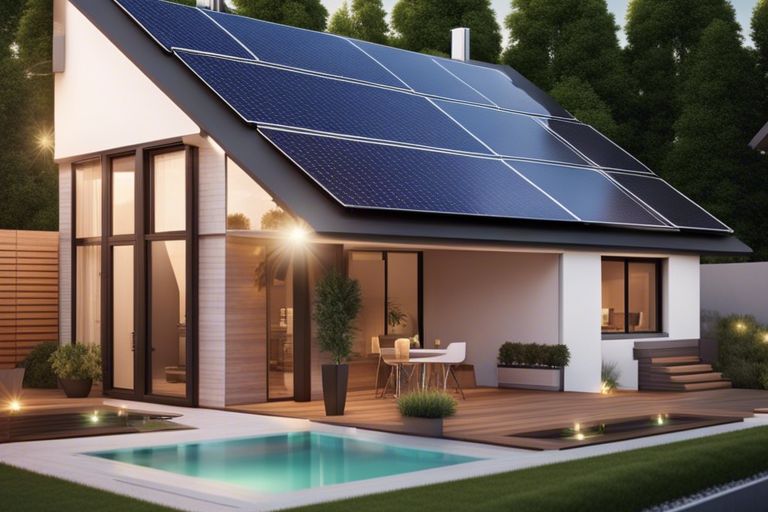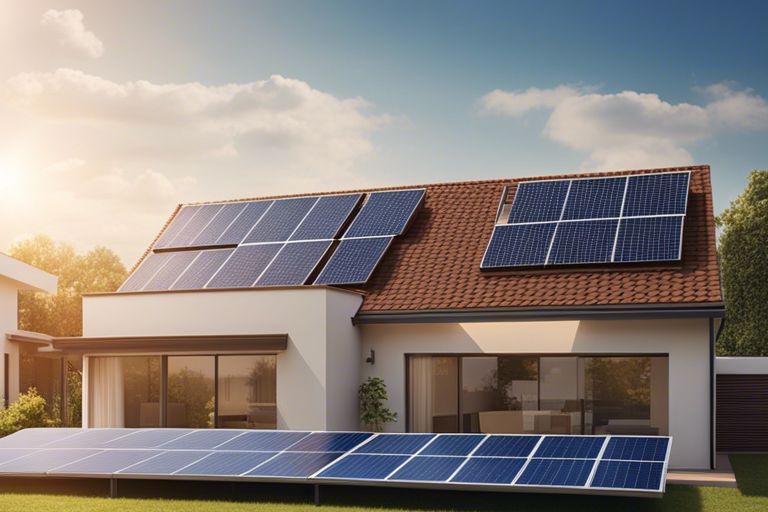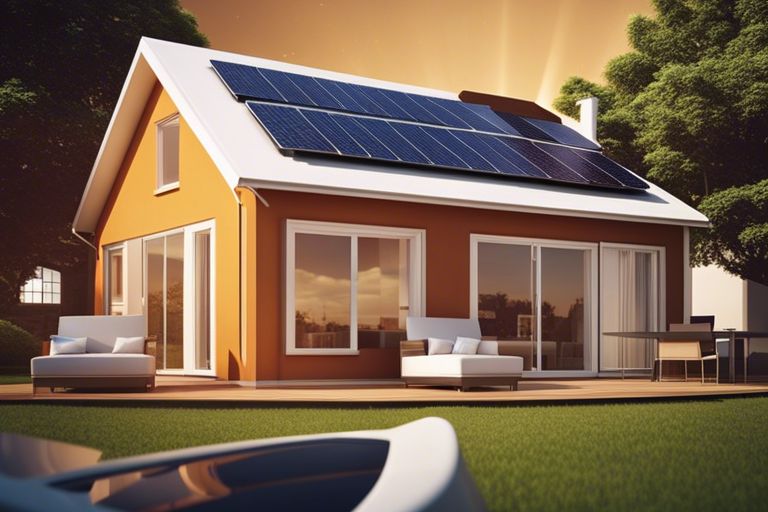Solar power is a sustainable and cost-effective way to power your household. Have you ever wondered how much solar power is needed to fully run your home? In this informative post, we will break down the calculations and factors involved in determining the right amount of solar power for your household needs. By the end, you will have a better understanding of how to make the switch to solar energy in a way that is efficient and practical for your home.
Key Takeaways:
- Calculating Energy Needs: To determine how much solar power is needed to run a household, it’s necessary to calculate the average energy consumption of the household.
- System Size: The size of the solar power system required depends on factors like roof space, location, energy usage patterns, and efficiency of solar panels.
- Efficiency and Storage: Investing in energy-efficient appliances and incorporating storage solutions like batteries can enhance the overall effectiveness of a solar power system for a household.

Determining Your Energy Needs
While How Many Solar Panels to Power a House? 4 Facts to Know gives you a general idea of the number of solar panels required, it’s important to determine your specific energy needs before investing in a solar power system. Calculating your daily energy consumption is the first step in understanding how much solar power you need to run your household efficiently.
Calculating Your Daily Energy Consumption
Calculating your daily energy consumption involves taking stock of the electrical appliances and devices you use on a typical day. You can find the power consumption ratings (in watts) of your devices either on the back or bottom of the appliance or in the user manual. By adding up the total wattage of all your devices and estimating the number of hours each device is used per day, you can get a rough estimate of your daily energy consumption.
Factors Affecting Energy Requirements
Requirements for energy can vary based on several factors such as the size of your household, the climate in your area, and your lifestyle habits. For instance, larger households with more occupants will generally require more energy to power appliances and devices. Similarly, extreme weather conditions may lead to increased energy usage for heating or cooling purposes. Lifestyle habits like working from home or using energy-intensive equipment can also impact your overall energy needs.
- Factors that may affect your energy requirements include:
- Number of occupants in your household
- Climate and weather conditions in your area
- Your daily routines and lifestyle habits
After considering these factors, you can better understand your energy needs and make an informed decision on the size and capacity of the solar power system required to meet your household’s requirements.
To Sum Up
To accurately determine how much solar power is needed to run your household, it’s imperative to first calculate your daily energy consumption and consider the various factors that can influence your energy requirements. By understanding your specific energy needs, you can tailor your solar power system to efficiently meet the demands of your household while maximizing energy savings and sustainability.
Assessing Your Solar Power Potential
Evaluating Your Roof’s Solar Exposure
For assessing your solar power potential, you first need to evaluate your roof’s solar exposure. Start by looking at your roof’s orientation and the amount of shade it receives throughout the day. Ideally, your roof should be facing south to maximize sunlight exposure. Additionally, trees, buildings, or other structures that cast shadows on your roof can impact the efficiency of your solar panels. Make sure your roof has enough unobstructed space to install the panels and receive adequate sunlight.
Considering Local Climate and Weather Patterns
Evaluating the local climate and weather patterns is crucial when determining your solar power potential. Factors such as the number of sunny days, average annual rainfall, and seasonal weather fluctuations can affect the efficiency of your solar panels. In areas with frequent cloudy days, you may need to install additional panels to compensate for reduced sunlight exposure. On the other hand, regions with long sunny days can generate more solar power, allowing you to potentially produce excess energy to sell back to the grid.
Patterns
Consider the weather patterns in your area to understand how they influence your solar power potential. For example, if you live in a region prone to heavy snowfall or dust storms, you need to factor in regular cleaning and maintenance of your solar panels to ensure optimal performance. By being aware of your local weather conditions, you can better plan for any challenges that may impact the efficiency of your solar power system.
Sizing Your Solar Panel System
Calculating the Required System Size
Keep in mind that the size of your solar panel system should be based on your household’s energy consumption. To calculate the required system size, start by examining your electricity bill to determine your average daily energy usage in kilowatt-hours (kWh). This information will help you estimate the number of solar panels needed to cover your energy needs efficiently.
Choosing the Right Panel Efficiency
Your solar panel system’s efficiency is crucial in maximizing energy production. When dicking out panels, consider their efficiency rating, which indicates how much sunlight they can convert into electricity. Higher efficiency panels may cost more initially but can generate more electricity in limited space, making them a worthwhile investment in the long run.
Solar panels with higher efficiency ratings are ideal for rooftops with limited space or for those looking to maximize energy production from their solar system. By choosing panels with higher efficiency, you can generate more electricity even when your roof has limited available space for solar panel installation. This can help you offset a larger portion of your energy usage with a smaller number of panels.

Energy Efficiency and Conservation
Identifying Energy-Wasting Appliances
To ensure your household is running efficiently on solar power, it’s necessary to identify energy-wasting appliances. An easy way to do this is by monitoring your energy consumption using a smart energy monitor. This device can help you pinpoint which appliances are consuming the most energy, allowing you to make informed decisions on where to cut back.
Older appliances are often energy hogs compared to newer, more energy-efficient models. Keep an eye out for appliances such as refrigerators, air conditioners, and water heaters, as these tend to be the biggest culprits when it comes to energy consumption. By identifying and addressing these energy-wasters, you can significantly reduce your overall energy usage.
Implementing Energy-Saving Strategies
Implementing energy-saving strategies in your daily life can make a considerable difference in your household’s energy consumption. Simple changes, such as switching to LED light bulbs, installing a programmable thermostat, and using power strips to easily turn off electronics, can lead to significant savings over time.
This section will provide you with practical tips and strategies to help you lower your energy usage and reduce your reliance on non-renewable energy sources. By making small changes to your habits and routines, you can contribute to a more sustainable future while also saving money on your energy bills.
System Configuration and Installation
Configuring Your System for Maximum Output
Despite the abundant energy provided by the sun, it’s imperative to configure your solar power system properly to ensure maximum efficiency. When setting up your system, consider factors such as the orientation and angle of your solar panels, as well as potential shading from nearby trees or buildings. By optimizing these variables, you can improve the overall performance of your system and generate more electricity for your household.
Hiring a Professional Installer
For a seamless and hassle-free installation process, it’s recommended to hire a professional solar installer. These experts have the knowledge and experience to design and set up a system that meets your household’s specific energy needs. Additionally, professional installers can help navigate any local regulations or permits required for installing solar panels on your property.
A professional installer can also provide valuable insights on the best placement of solar panels and help you choose high-quality components for your system. By enlisting the services of a skilled installer, you can ensure that your solar power system is installed correctly and operates efficiently for years to come.

Cost and Financing Options
Estimating the Total System Cost
Your first step in transitioning to solar power is to estimate the total system cost. This cost includes the solar panels, mounting equipment, inverter, batteries (if you choose to go off-grid), installation, and any additional fees. Any reputable solar company can provide you with a detailed quote customized to your household’s energy needs and geographical location.
Exploring Incentives and Financing Opportunities
Financing your solar power system can be approached in various ways. Many governments offer incentives such as tax credits or rebates to homeowners who go solar. Financing options like solar loans or power purchase agreements (PPAs) can make solar power more affordable by spreading out the cost over time. By partnering with solar financing companies, you can find a solution that fits your budget and allows you to start saving on your electricity bills from day one.
Cost should not be a barrier to adopting solar power for your household. With the right financing options and incentives, you can make the switch to clean, renewable energy and start enjoying the benefits of lower electricity bills and reduced environmental impact.
Conclusion
Presently, you now have a clearer understanding of how much solar power is needed to run a household. By considering factors such as the energy consumption of your appliances, the amount of sunlight your location receives, and any potential energy storage needs, you can determine the right size solar system for your home. It’s important to note that investing in solar power not only benefits the environment but can also result in long-term cost savings on your energy bills.
Be mindful of, each household’s energy needs are unique, so it is recommended to consult with a solar energy specialist to determine the most efficient and cost-effective solar power system for your home. By making the switch to solar energy, you can take control of your energy consumption and reduce your dependence on traditional fossil fuels, ultimately leading to a more sustainable future for you and your family.
FAQ
Q: How do I determine how much solar power is needed to run my household?
A: To determine how much solar power you need, you should first calculate your daily energy consumption in kilowatt-hours (kWh). You can do this by analyzing your electricity bills or using an online energy consumption calculator. Once you have this information, you can estimate the size of the solar system required to meet your household’s energy needs.
Q: What factors influence the amount of solar power needed for a household?
A: Several factors can influence the amount of solar power needed for a household, including the household’s energy consumption patterns, the size and efficiency of the solar panels, the geographical location (solar irradiance), the angle and orientation of the solar panels, shading from nearby buildings or trees, and the availability of net metering or energy storage options.
Q: Can solar power alone run a household completely off the grid?
A: In many cases, yes. With the right-sized solar power system, energy-efficient appliances, and sufficient energy storage capacity (such as batteries), it is possible for a household to operate completely off the grid using solar power. However, it’s important to consider factors such as energy consumption habits and backup power options during times of low sunlight or system maintenance.
